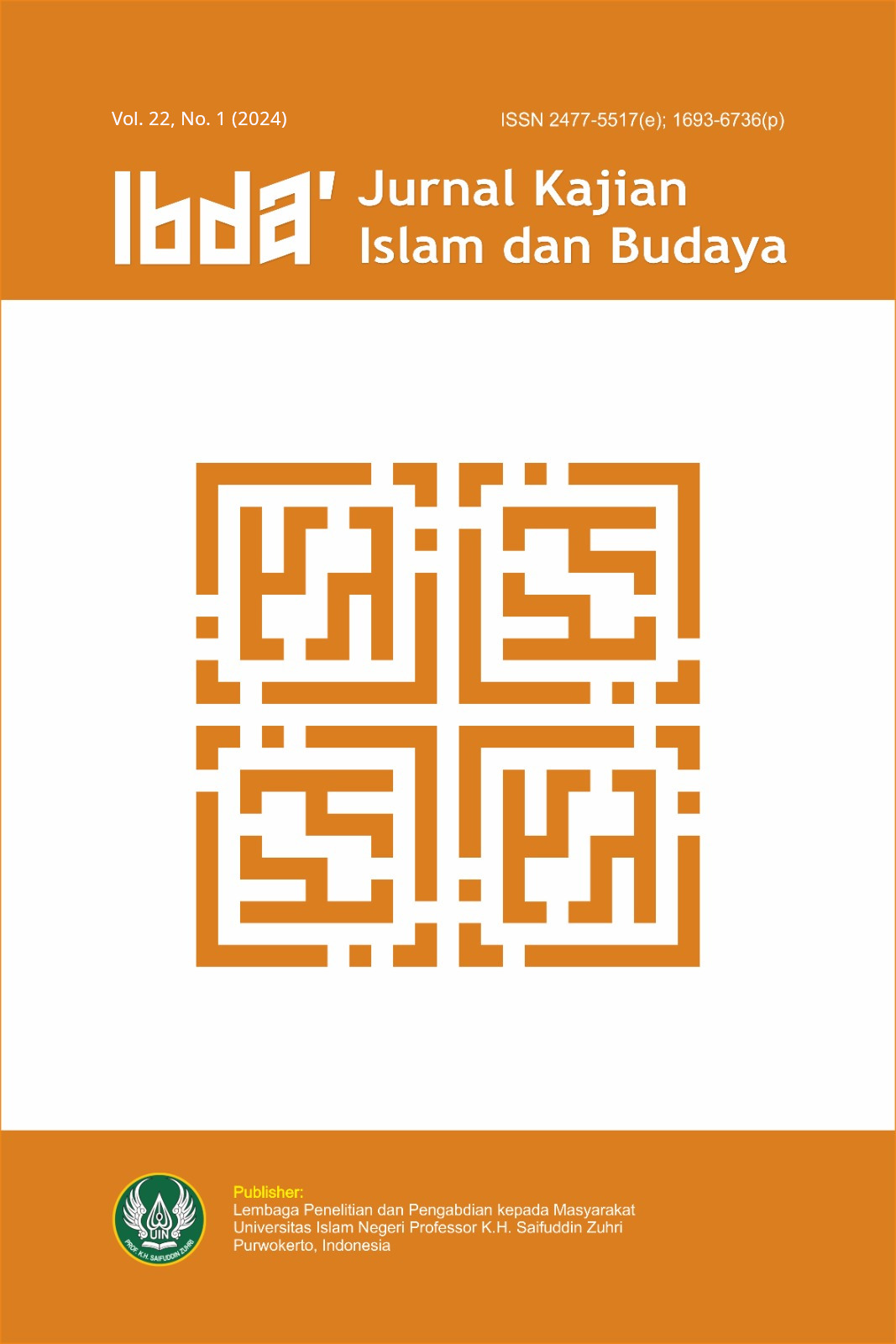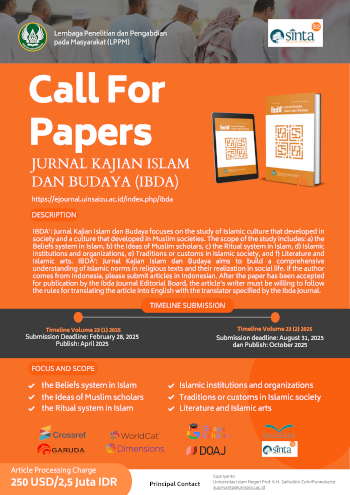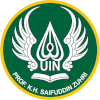The Synergy Between Islam and The Local Culture of Maluku, Indonesia
DOI:
https://doi.org/10.24090/ibda.v22i1.8422Keywords:
Islamic culture, moluccan culture, acculturation, assimilationAbstract
The cultural context of the Maluku archipelago is greatly influenced by Islam, which profoundly impacts the way of life of its diverse communities. Religion exists alongside and interacts with society's social dynamics while incorporating specific cultural values. This study aims to analyze and gain insight into the distinct concept of Islam in Maluku as it undergoes continuous development in conjunction with the local culture. A qualitative research approach is employed, specifically focusing on emic perspectives. Priority is given to the views and interpretations of local informants. Moreover, the ideation process is enhanced by incorporating literature studies; efforts to conceptualize the ideas in this writing were enriched by using qualitative research methods, selected data sources, and prioritizing the emic perspective. The informants' views were prioritized in terms of how they view and interpret the world from their perspective, together with literature studies and various references related to the topic. The study findings indicate that Islam has experienced growth and evolution in Maluku as a religion, resulting in its interaction with diverse local cultures. The culture of the Moluccans has changed over time, originating in their early settlement. This has resulted in forming a community that has developed its distinct values, which revolve around human relationships and the environment. Islam offers a logical reasoning for preserving Moluccan culture, promoting peaceful coexistence among the people of Maluku, and serving as an example of socio-religious integration.Downloads
References
Abdurrahman, W. (2001). The Struggle of State, Religion, and Culture. Desantara.
Adnan, R. S. (2023). The Dynamic Role of Moslem in Building Indonesia as a Nation-State. Indonesian Journal of Religion and Society, 5(1), 58-69.
Aholiab, W. (2005). New Maluku – The Rise of the Machine of Existence of the Children of the Country. Canisius.
Alba, R., & Duyvendak, J. W. (2020). What about the Mainstream? Assimilation in Super-Diverse Times. In Super-Diversity in Everyday Life (pp. 105-124). Routledge.
Bashori, B. (2017). Modernization of Pesantren Educational Institutions Azyumardi Azra Perspective. Nadwa: Journal of Islamic Education, 11(2). https://doi.org/DOI: 10.21580/nw.2017.11.2.1881
Cassirer, E. (2023). An Essay on Man: An introduction to a Philosophy of Human Culture (Vol. 23). Felix Meiner Verlag.
Cooley L. F. (2000). Mimbar and Throne. (II). Sinar Harapan Library.
Department of Education and Culture & Research Center for History and Culture. (2007). Customs and Marriage Ceremonies of the Moluccan Region.
Hägerdal, H. (2024). History of the Banda Sea. In Oxford Research Encyclopedia of Asian History.
Islam, T., Khan, M. K., & Asad, M. (2020). Workplace Spirituality in South Asian Context: The Role of Learning Culture, Organizational Support and Knowledge Sharing. South Asian Studies, 34(1).
Izogo, E. E., & Mpinganjira, M. (2020). Behavioral Consequences of Customer Inspiration: The Role of Social Media Inspirational Content and Cultural Orientation. Journal of Research in Interactive Marketing, 14(4), 431-459.
Jack-Hinton, C. (2022). The Political and Cosmographical Background to the Spanish Incursion into the Pacific in the Sixteenth Century. In Southeast Asia Colonial History V1 (pp. 9-41). Routledge.
Karataş, S., Crocetti, E., Schwartz, S. J., & Rubini, M. (2020). Understanding Adolescents’ Acculturation Processes: New Insights from the intergroup Perspective. New directions for Child and Adolescent Development, 2020(172), 53-71.
Koentjaraningrat (2015). Culture of Mentality and Building (Revised Edition). Rineka Cipta.
Mcevoy, J. G. (2022). Cultural Plurality and Inculturation: Foundations for Intercultural Dialogue. Irish Theological Quarterly, 87(4), 259-279.
Nuraeni, H. G., & Alfan, M. (2013). Cultural Studies in Indonesia (Cet. I,). Faithful Library.
Nurdin, A. (2013). Revitalization of Local Wisdom: A Study of Conflict Resolution in West Kalimantan, Maluku and Poso. Journal of Islamic Studies Analysis, 13(1).
Palombo, C. (2021). Studying Trade and Local Economies in Early Islamicate Societies: Responses to the ‘Long-Divergence’Debate from Islamic History. Cromohs-Cyber Review of Modern Historiography, 24, 161-181.
Putuhena, H.M. Shaleh, et al., (2009). History and Life Wisdom of the Central Moluccan Community. PS2BM and PTD.
Tubaka, A. M. (2018). Islam Maluku: Dialectics, Religion &; Culture in the Pela-Gandong Tradition. LP2M IAIN.
Uneputty. T. J. A. (2012). The Unity System of Life of the Moluccan Community. Ministry of Education and Culture Cultural History Research Center.
W. Y. Tiwery, F. Salatalohy (Co-author). (2004). Fringe nationalism; From Maluku, About Maluku for Indonesia. LKiS.
Walton, J. H. (2015). The Lost World of Adam and Eve: Genesis 2-3 and the Human Origins Debate. InterVarsity Press.
Downloads
Published
How to Cite
Issue
Section
License
Copyright (c) 2024 Dortje Leonora Yokbeth Lopulalan, Selvianus Salakay, Makmur Harun

This work is licensed under a Creative Commons Attribution-ShareAlike 4.0 International License.
Authors who publish with this journal agree to the following terms:
- Authors retain copyright and grant the journal right of first publication with the work simultaneously licensed under a Creative Commons Attribution-ShareAlike License a that allows others to share the work with an acknowledgement of the work's authorship and initial publication in this journal.
- Authors are able to enter into separate, additional contractual arrangements for the non-exclusive distribution of the journal's published version of the work (e.g., post it to an institutional repository or publish it in a book), with an acknowledgment of its initial publication in this journal.
- Authors are permitted and encouraged to post their work online (e.g., in institutional repositories or on their website) before and during the submission process, as it can lead to productive exchanges, as well as earlier and greater citation of published work (See The Effect of Open Access).
















